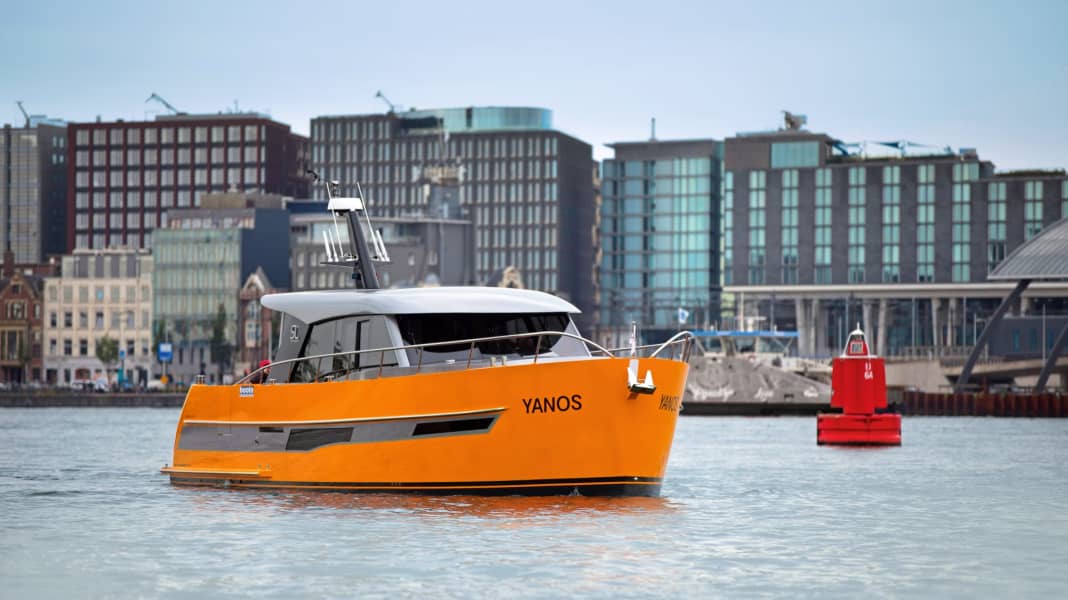
One thing is clear, our test boat, the Super Lauwersmeer Discovery 47 OC, is easy to spot from afar, as its bright orange hull is hard to miss. The colour scheme was of course the owner's own idea - like so much else on this boat.
But that is precisely the recipe for the Super Lauwersmeer. The shipyard offers the 47 OC as a so-called semi-custom boat, which means that the owner can have a say and plan much of their boat themselves. According to Bastiaan Jousma, director and owner of Super Lauwersmeer, this is the case with our test boat,only about ten per cent of the standard version remains.
Let's start below deck: There is a large owner's cabin in the bow, in which a double bed measuring around 1.90 x 2.13 metres offers plenty of space for two adults. To make sleeping a pleasure, there are slatted frames under the mattresses. There are large hatches in the cabin roof to provide light and, above all, fresh air.





If you step from the forward cabin into the vestibule, you will find the doors to the toilet and shower room. To starboard is the wet room with a double washbasin and a spacious shower cubicle. The room opposite has a large toilet bowl and a wash hand basin.
A little further towards the saloon is the entrance to the underfloor cabin, which is equipped with two single berths that are also fitted with slatted frames. You realise how important this equipment is to the owner when you look at the emergency berth in the huge storage space under the cockpit floor - even here there is a slatted frame.
There is a comfortable L-shaped bench in the open cockpit; opening the stern door to the saloon creates a huge, deep living area, which gives the whole thing a lounge character. Practical: the galley is then in the centre. In general, the kitchen has a lot to offer, as it is huge and fully equipped.
You can even try your hand at preparing real menus. Dining takes place either in the saloon or in the aforementioned seating area in the stern.
The driving position is on the starboard side next to the companionway to the bedrooms. Here the owner has opted for an armchair with armrests, which is almost naturally made of the same leather as the saloon sofas. The driver's seat can be swivelled and moved forwards and backwards.
This allows me to find a position in which I can sit and drive comfortably. It's also easy to drive standing up, just push the seat aft. Two Raymarine monitors provide information about the course, engine data, tank levels and on-board power supply.
Our sailing area was the Port of Amsterdam. In the Sixhaven marina, the bow and stern thrusters were able to put their skills to the test, as our berth was in a very narrow spot. If you wanted to stand outside on the side deck, no problem, because our boat could be steered by hand remote control (bow/stern thruster and gearbox).
Once outside the Port of Amsterdam, we had to deal with a moderate choppy wave, which the hull travelled through smoothly.
When holding course, the motto is "let it level out and correct only a little". If you don't feel like it, simply switch on the autopilot, which is particularly relaxing on longer sea voyages. Theoretically, these trips can be almost 500 nm long, because at an economical cruising speed of around 1750 rpm at a good 6 knots, the consumption is 1.30 l/sm, which, together with the 750-litre tank, gives the range mentioned above plus 15% reserve.
At full throttle, on the other hand, you won't even get half as far at 172 nm. At very slow speeds (3.5 knots), the range is in the four-digit range.
When it comes to noise, the Super Lauwersmeer impresses with low measured values: 66 dB/A at full throttle and a pleasant 55 dB/A at cruising speed - both measured at the driver's ear. That leaves manoeuvring at high speed. Here, the boat's behaviour is typical of a displacement boat and leans moderately on the outside of the bends. When manoeuvring in, the skipper needs to have fairly strong arms; when manoeuvring out, the rudder is noticeably easier to turn.
In the event of problems with the hydraulic steering, the Discovery can be steered with an emergency tiller from the stern stowage box under the cockpit. Other safety equipment includes a fire extinguishing system, fire extinguisher, double diesel and cooling water filters, stopcock, gas alarm and emergency step on the hull to climb onto the bathing platform.
emergency step on the hull to climb onto the bathing platform.
Two electric bilge pumps are also part of the standard equipment, but the hand bilge pump required by BOOTE is not.
Anyone wishing to carry out a daily visual inspection of the engine compartment climbs into the rear storage compartment and from there through a door opening with a thick bulkhead door. There is plenty of space around the engine, but with a standing height of just over one metre, service work can only be carried out while kneeling. The technicians laid the cables and hoses firmly and clearly.
With the exception of a few sharp corners on the helmstand cover, refrigerator handle and saloon door, the workmanship of all parts of the solid folding frame made of 5 mm (hull) and 4 mm (superstructure) thick steel is impressive. The cross bollards and the railing that surrounds the wide, low-lying and non-slip side decks also make a robust impression.

